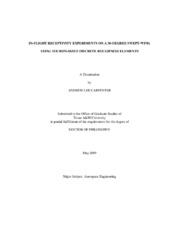| dc.contributor.advisor | Saric, William S. | |
| dc.creator | Carpenter, Andrew L. | |
| dc.date.accessioned | 2010-01-16T00:10:29Z | |
| dc.date.available | 2010-01-16T00:10:29Z | |
| dc.date.created | 2009-05 | |
| dc.date.issued | 2010-01-16 | |
| dc.identifier.uri | https://hdl.handle.net/1969.1/ETD-TAMU-2009-05-728 | |
| dc.description.abstract | One of the last remaining challenges preventing the laminarization of sweptwings
is the control of unstable crossflow vortices. In low-disturbance environments the
transition from laminar to turbulent flow on the swept-wing initially takes the path of
receptivity, where surface roughness or disturbances in the environment introduce shortwavelength
disturbances into the boundary layer. This is followed by development and
linear growth of stationary crossflow vortices that modify the mean flow, changing the
stability characteristics of the boundary layer. Finally, breakdown to turbulence occurs
over a short length scale due to the high-frequency secondary instability. The receptivity
mechanism is the least understood, yet holds the most promise for providing a laminar
flow control strategy. Results of a 3-year flight test program focused on receptivity
measurements and laminar flow control on a 30-degree swept-wing are presented. A
swept-wing test article was mounted on the port wing of a Cessna O-2A aircraft and
operated at a chord Reynolds number of 6.5 to 7.5 million. Spanwise-periodic, micronsized
discrete roughness elements were applied at the leading edge of the swept-wing in
order to excite the most unstable crossflow wavelength and promote early boundary layer transition. An infrared camera was used to detect boundary-layer transition due to
changes in leading-edge roughness. Combined with the IR camera, a new technique of
calibrating surface-mounted hotfilms was developed for making disturbance-amplitude
measurements downstream of modulated roughness heights. This technique proved to be
effective at measuring disturbance amplitudes and can be applied in future tests where
instrumentation is limited. Furthermore, laminar flow control was performed with
subcritically-spaced roughness. A 100% increase in the region of laminar flow was
achieved for some of the conditions tested here. | en |
| dc.format.mimetype | application/pdf | |
| dc.language.iso | en_US | |
| dc.subject | Receptivity | en |
| dc.subject | Laminar Flow | en |
| dc.subject | Boundary Layer | en |
| dc.subject | Swept-Wing | en |
| dc.subject | Roughness | en |
| dc.subject | Hotfilms | en |
| dc.subject | Infrared Thermography | en |
| dc.subject | Flight Test | en |
| dc.title | In-flight Receptivity Experiments on a 30-degree Swept-wing using Micron-sized Discrete Roughness Elements | en |
| dc.type | Book | en |
| dc.type | Thesis | en |
| thesis.degree.department | Aerospace Engineering | en |
| thesis.degree.discipline | Aerospace Engineering | en |
| thesis.degree.grantor | Texas A&M University | en |
| thesis.degree.name | Doctor of Philosophy | en |
| thesis.degree.level | Doctoral | en |
| dc.contributor.committeeMember | Reed, Helen L. | |
| dc.contributor.committeeMember | Ward, Donald T. | |
| dc.contributor.committeeMember | Duggleby, Andrew | |
| dc.type.genre | Electronic Dissertation | en |


